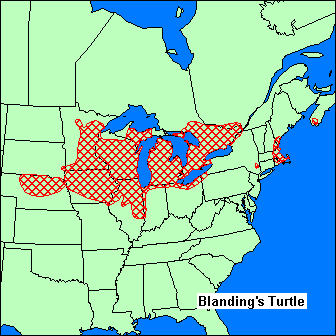By: Simon D., Jake T., Alexandra J., and Kevin L.
Photo credit: Toronto Zoo
Only four communities of turtles in different areas are known to have
50+ adult Blanding’s turtles in them.
They get crushed by cars, or eaten by predators.
Photo credit: Toronto Zoo
Only four communities of turtles in different areas are known to have
50+ adult Blanding’s turtles in them.
They get crushed by cars, or eaten by predators.
Very few Blanding’s turtles survive their walk back to the wetlands they come from.
They can be eaten by predators, or run over by car on man made roads.
They can be eaten by predators, or run over by car on man made roads.
The blanding’s turtle is easy to capture, so many poachers
try to capture them while they’re going to and from nesting sites.
try to capture them while they’re going to and from nesting sites.
The Blanding’s turtles cannot travel long distances.
So if their habitat is lost, they may not be able to relocate to a different region.
Range and Population
By Michael Elinskas, Allie Valvano, and Stefano Adelfio

From the New York State Department of Environmental Conservation
https://www.dec.ny.gov/animals/7166.html
Near the Great lakes St. Lawrence the estimate current size is 10,000 individuals.
So if their habitat is lost, they may not be able to relocate to a different region.
Range and Population
By Michael Elinskas, Allie Valvano, and Stefano Adelfio
From the New York State Department of Environmental Conservation
https://www.dec.ny.gov/animals/7166.html
Near the Great lakes St. Lawrence the estimate current size is 10,000 individuals.
Every month people from Kestrel have been coming in to talk to us about the local
blanding’s turtles.
We have been monitoring the growth of two turtles named Bert and Ernie.
We have been measuring their length and mass as they have been growing.
We have been monitoring for about the whole school year and they are
growing so much.
In the beginning weighed 9-11 grams and they had to have different kind of foods
We measure and weigh them we also take care of them like feed them,
keep them warm and safe.
They both dont have the same food.
 art by Allie Valvano
art by Allie Valvano
blanding’s turtles.
We have been monitoring the growth of two turtles named Bert and Ernie.
We have been measuring their length and mass as they have been growing.
We have been monitoring for about the whole school year and they are
growing so much.
In the beginning weighed 9-11 grams and they had to have different kind of foods
We measure and weigh them we also take care of them like feed them,
keep them warm and safe.
They both dont have the same food.

No comments:
Post a Comment